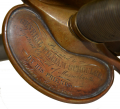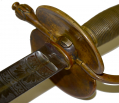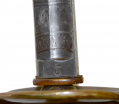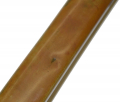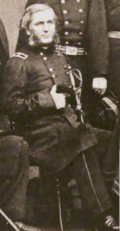site search
online catalog
HISTORICAL PRESENTATION MODEL 1840 GENERAL OFFICER’S SWORD OF WILLIAM SCHOULER, ADJUTANT GENERAL OF MASSACHUSETTS 1860: HE PREPARED THE “MINUTEMEN OF ‘61”

$8,550.00 SOLD
Originally $9,500.00
Quantity Available: None
Item Code: 870-343
This sword has a wonderful undisturbed patina on the exterior and bright blade with vivid etching that really catches the eye when drawn. It also bears a great 1860 inscription to the Adjutant General Schouler of Massachusetts, who was largely responsible for the state’s ability to send troops quickly to Washington’s defense immediately after the firing on Fort Sumter in 1861.
The Model 1840 general officer’s sword has a long period of use and many model designations to prove it: the Model 1840, 1841, 1851, and 1861. Introduced with the other 1840 patterns, its specifications were something of an afterthought, published only in 1841, and in theory for the major general commanding only- hence the second model designation. Essentially a high-grade version of the 1840 foot officer sword, it was distinguished by higher quality gilding and a metal scabbard elaborately engraved and fitted with a double-ring upper mount (and a lower single ring mount) often fitted with a long frog stud as well. The overall pattern was a hybrid of the U.S. 1834 officer’s sword and older British, French, and Prussian designs. It remained in the 1851 regulations, being pictured in Horstmann’s catalog- hence the third designation, and in the 1861 regulations as well. Of course, generals might claim some latitude in their chosen arms, so there was overlap with the earlier 1834 pattern and with the later1860 Staff sword that was often carried by general officers as well, but the pattern is still shown in the 1864 Schuyler, Hartley and Graham catalog as the “general officer’s sword,” and newly-minted brigadier general Ulysses Grant even cradles one in an early photo, showing the force of regulations. Militia officers might have even more leeway, though Massachusetts specified its officers would carry swords as closely following U.S. regulations as possible and former Massachusetts Governor Nathaniel Banks is pictured as general posing with one.
The hilt is the standard configuration with lantern-shaped pommel, and bears the high capstan typical of these swords as made by Weyersberg brothers of Solingen and bears their king’s head blade stamp on the reverse ricasso. This sword was formerly in the collection of Kevin Hoffman, who labeled it a product of Horstmann, with whom the Weyersbergs had a strong relationship, and Thillmann illustrates a dead-on parallel with one bearing an etched Horstmann address (US Army Swords, 227.) This one does not have the Horstmann address, however, and it is difficult to picture giving a Boston-based Massachusetts adjutant general a sword from a Philadelphia firm, though it is possible it came to a Boston firm through Horstmann in some fashion. Thillmann notes that “Horstmann type” etching, such as this has, “is also seen on unmarked examples and those with only the Gebruder Weyersburg blade strike of a king’s head.”
The hilt also has the standard cast and chased floral decoration with double clamshell guard using a folding reverse counterguard retained by a spring button. The grip has straight, rather than spiral ribs, as seen on other Weyersberg versions, and is cast brass rather than silver, but likely had a silver wash worn from handling. This corresponds with the patina of the hilt and scabbard, both of which would have had a high-grade gilt finish, but now show as nicely patinated aged brass as well. This would be unusual for most general officer’s swords, which be laid aside in favor of something less fancy for field use, but in this case, it was likely the only sword he owned and subject to daily, if not field, wear. The obverse counterguard is nicely engraved in a combination of script and block letters, shaded and unshaded, in flowing lines with flourishes, “Presented to / General William Schouler / Adjutant General of Massachusetts / by his friends / Boston, May, 1860.”
The blade is the standard spadroon form, with flat back edge, spearpoint and false edge. There are no nicks. The finish is bright and the etching is vivid. The reverse etching has latticework and a palmette followed by leafy scrolls leading up to an eagle with arrows and olive brand clutching an E Pluribus Unum ribbon in its beak with six stars overhead and sunburst glory, ending with a long branch with berries and leaves. The obverse starts with a palmette, lattice work and urn with leafy vine, followed by a lengthwise U.S. in a cartouche with stars around it, floral borders and flame like terminals top and bottom. The panel ends with long leafy branch knotted at the bottom by a ribbon. On both sides the frosting ends with leaf-like edges. There are just minor gray spots. The edge and point are good. The back edge of the blade is etched as well.
The scabbard patina matches the hilt and the scabbard is elaborately engraved at the ring mounts and for a distance up from the drag with floral motifs around at the edges and at the center rising along the border of a chevron. Between the upper middle ring bands is a very nice eagle perched with raised wings atop of US shield, that is bordered by the geometric branches of a wreath that knotted at bottom. The lower floral engraving of the drag shows a stippled center. The condition is very good, but with a small dent on either side of the very tip of the drag and a couple of shallow pushes to the reverse of the scabbard, not of which is fairly common from use and not very obtrusive. The Horstmann marked example in Thillmann (227-228,) furnishes a very nice parallel for the blade etching, though that one incorporates a Horstmann address, and for the scabbard engraving, shape of the drag, and the long “frog clip” on the upper two-ring mount.
Schouler was an important figure for the Massachusetts militia and the state’s military readiness in the secession crisis. Born in 1814, he came to the U.S. at a young age with his parents from Scotland. Raised in New York and Massachusetts, he ran the Lowell “Courier” newspaper from 1841 to 1848 and was later part owner of the Boston “Atlas.” Probably as a result, he developed political connections, even serving a term as state representative and delegate to the state’s constitutional convention in 1853. From 1853 to 1858 he lived in Ohio, editing the Cincinnati “Gazette” and “Ohio State Journal.” Governor Salmon P. Chase made him Adjutant General of Ohio in 1855, and after returning to Massachusetts in 1858 he was given the same post by Governor Nathaniel Banks in 1860, the obvious occasion for the presentation. He was well thought of and was continued in his post by Governor Andrew in 1861, holding the office until 1867. When the war broke out he was noted for his organizational skill and political acumen as he, “organized and recruited Massachusetts regiments, consolidating fragmentary bodies in the State camps, and applying immeasurable tact and kindness to reduce the friction so constantly engendered among raw military aspirants and raw enlisted men… Besides other high officials and legislators in his own State, he had national military organizers and officials to encounter...”
He also played a key role in preparations of the state’s forces for field service, such as an early appropriation for 2,000 overcoats and other supplies for troops who might be needed quickly. One of his biggest contributions was made immediately after the secession of South Carolina in December 1860. He wrote to Governor Banks suggesting rolls of the militia companies should be updated and companies brought up to full strength. Banks left office days later, but his suggestions were implemented by Governor Andrew in General Order No. 4 of 16 January 1861, which also ordered the discharge of any who would be unable or indisposed for any reason to respond to an emergency call, “so that their places may be filled by men ready for any public exigency which may arise, whenever called upon.” With these and other measures in place, on news of Fort Sumter the state was able to dispatch troops very quickly to Washington, earning them the title of, “Minutemen of 1861.”
Schouler later served in the state senate, and authored a two-volume history of Massachusetts in the war. He died in 1872. One of his other enduring legacies was his involvement with the famous letter of Abraham Lincoln addressed to Mrs. Bixby on the loss of her five sons. But that is another story.
This is a great sword: scarce in its own right, in excellent condition, and presented to a figure very important in the defense of the Union. We illustrate a photo of Schouler, in uniform, with this very sword, from Pearson’s 1894 two-volume biography of Governor Andrew. [sr] [ph:m]
~~~~~~~~~~~~~~~~~~~~~~~~~~~~~~~~~~~
THIS ITEM, AS WITH ALL OTHER ITEMS AVAILABLE ON OUR WEB SITE,
MAY BE PURCHASED THROUGH OUR LAYAWAY PROGRAM.
CLICK HERE FOR OUR POLICIES AND TERMS.
THANK YOU!
Inquire About HISTORICAL PRESENTATION MODEL 1840 GENERAL OFFICER’S SWORD OF WILLIAM SCHOULER, ADJUTANT GENERAL OF MASSACHUSETTS 1860: HE PREPARED THE “MINUTEMEN OF ‘61”
For inquiries, please email us at [email protected]
Most Popular
Historical Firearms Stolen From The National Civil War Museum In Harrisburg, Pa »
Theft From Gravesite Of Gen. John Reynolds »
Selection Of Unframed Prints By Don Troiani »
Fine Condition Brass Infantry Bugle Insignia »
British Imported, Confederate Used Bayonet »
Scarce New Model 1865 Sharps Still In Percussion Near Factory New »
featured item
RARE PACK OF CONFEDERATE, RICHMOND ARSENAL, ARTILLERY FRICTION PRIMERS
Offered here is a very rare, nice condition, original pack of artillery friction primers manufactured at the Richmond Arsenal in Virginia during the Civil War. These “primers” are what was placed in the cannon vent hole and attached to a lanyard… (1268-512). Learn More »
site search
Upcoming Events
May 16 - 18: N-SSA Spring Nationals, Fort Shenandoah, Winchester, VA Learn More »







